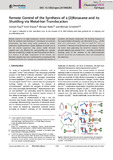Zitierlink:
http://dx.doi.org/10.25819/ubsi/10330| DC Element | Wert | Sprache |
|---|---|---|
| crisitem.author.orcid | 0000-0001-8525-885X | - |
| crisitem.author.orcid | 0000-0001-8622-2883 | - |
| dc.contributor.author | Paul, Indrajit | - |
| dc.contributor.author | Ghosh, Amit | - |
| dc.contributor.author | Schmittel, Michael | - |
| dc.date.accessioned | 2023-11-17T08:37:16Z | - |
| dc.date.available | 2023-11-17T08:37:16Z | - |
| dc.date.issued | 2019 | de |
| dc.description | Finanziert im Rahmen der DEAL-Verträge durch die Universitätsbibliothek Siegen | de |
| dc.description.abstract | Remote control in an eight-component network commanded both the synthesis and shuttling of a [2]rotaxane via metal-ion translocation, the latter being easily monitored by distinct colorimetric and fluorimetric signals. Addition of zinc(II) ions to the red colored copper-ion relay station rapidly liberated copper(I) ions and afforded the corresponding zinc complex that was visualized by a bright sky blue fluorescence at 460 nm. In a mixture of all eight components of the network, the liberated copper(I) ions were translocated to a macrocycle that catalyzed formation of a rotaxane by a double-click reaction of acetylenic and diazide compounds. The shuttling frequency in the copper-loaded [2]rotaxane was determined to k298=30 kHz (ΔH≠=62.3±0.6 kJ mol−1, ΔS≠=50.1±5.1 J mol−1 K−1, ΔG≠298=47.4 kJ mol−1). Removal of zinc(II) ions from the mixture reversed the system back generating the metal-free rotaxane. Further alternate addition and removal of Zn2+ reversibly controlled the shuttling mode of the rotaxane in this eight-component network where the ion translocation status was monitored by the naked eye. | en |
| dc.identifier.doi | http://dx.doi.org/10.25819/ubsi/10330 | - |
| dc.identifier.uri | https://dspace.ub.uni-siegen.de/handle/ubsi/2523 | - |
| dc.identifier.urn | urn:nbn:de:hbz:467-25233 | - |
| dc.language.iso | en | de |
| dc.rights | Namensnennung-Nicht-kommerziell 4.0 International | * |
| dc.rights.uri | http://creativecommons.org/licenses/by-nc/4.0/ | * |
| dc.source | ChemistryOpen ; 8(11), S. 1355–1360. - https://doi.org/10.1002/open.201900293 | de |
| dc.subject.ddc | 540 Chemie | de |
| dc.subject.other | Remote control | en |
| dc.subject.other | Metal-ion translocation | en |
| dc.subject.other | Colorimetric signals | en |
| dc.subject.other | Rotaxane shuttling | en |
| dc.subject.other | Chemical signaling | en |
| dc.subject.other | Metall-Ionen-Translokation | - |
| dc.title | Remote control of the synthesis of a [2]rotaxane and its shuttling via metal-ion translocation | en |
| dc.type | Article | de |
| item.fulltext | With Fulltext | - |
| ubsi.publication.affiliation | Department Chemie - Biologie | de |
| ubsi.source.issn | 2191-1363 | - |
| ubsi.source.issued | 2019 | de |
| ubsi.source.issuenumber | 11 | de |
| ubsi.source.pagefrom | 1355 | de |
| ubsi.source.pageto | 1360 | de |
| ubsi.source.place | Weinheim | de |
| ubsi.source.publisher | Wiley-VCH | de |
| ubsi.source.title | ChemistryOpen | de |
| ubsi.source.volume | 8 | de |
| Enthalten in den Sammlungen: | Geförderte Open-Access-Publikationen | |
Dateien zu dieser Ressource:
| Datei | Beschreibung | Größe | Format | |
|---|---|---|---|---|
| Remote_control_of_the_synthesis of_a_2_Rotaxane.pdf | 1.64 MB | Adobe PDF |  Öffnen/Anzeigen |
Diese Ressource ist urheberrechtlich geschützt. |
Seitenansichten
274
checked on 02.04.2025
Download(s)
37
checked on 02.04.2025
Google ScholarTM
Prüfe
Prüfe
Diese Ressource wurde unter folgender Copyright-Bestimmung veröffentlicht: Lizenz von Creative Commons


